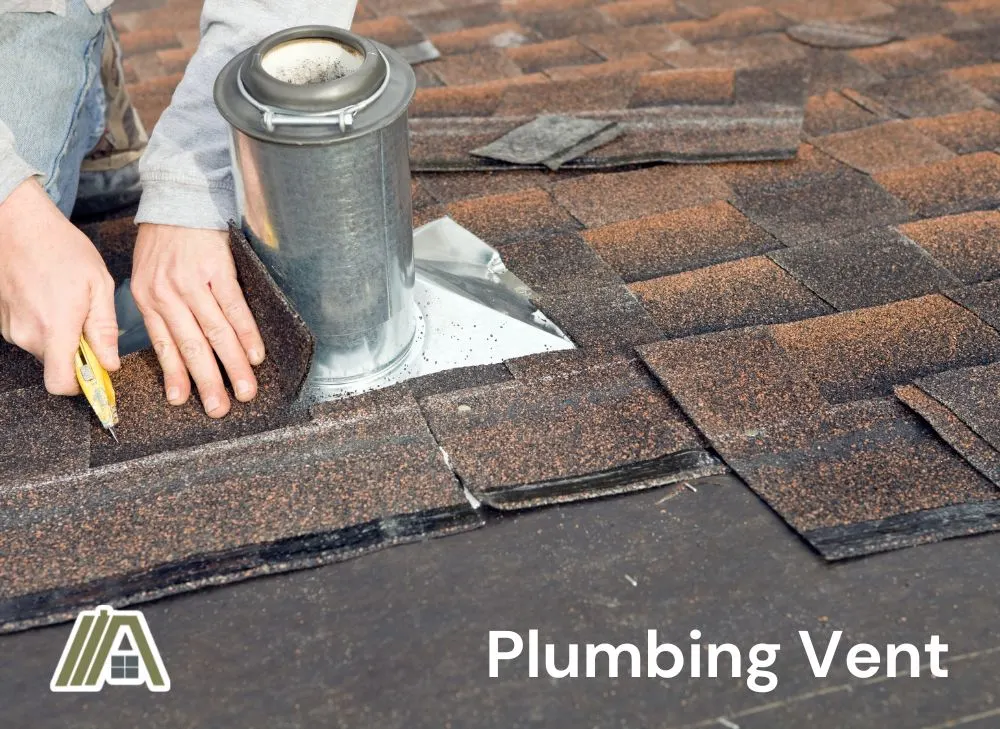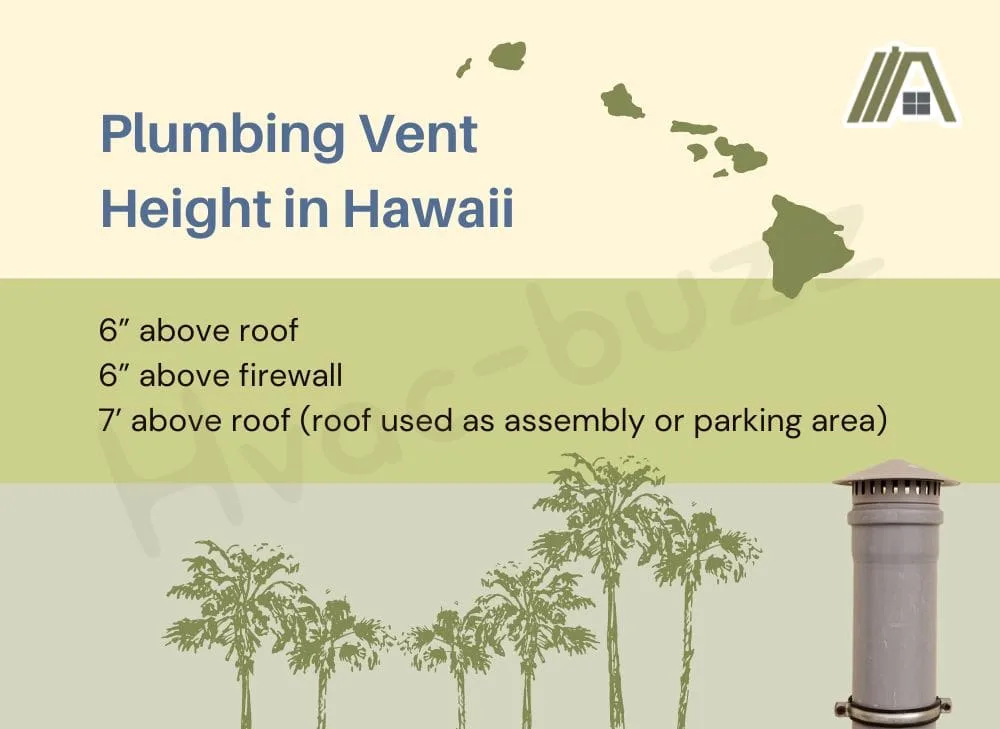The substances and odors carried in the air ejected by a plumbing vent are considered harmful to health and air quality. Thus, there are specific regulations for where and how plumbing vents terminate, including the height above a roof.
Height regulations are influenced by what the roof is used for and what state you are in due to weather factors. Some states have different requirements to suit these regional factors better, but most follow the guidelines set by the International Residential Code (IRC).

The IRC requires at least 6” above the roof or anticipated snow line/firewall, or 7′ above the roof if it is used for recreation, parking, or assembly. Only Connecticut, Delaware, Indiana, Maine, Michigan, Minnesota, Montana, New Hampshire, Ohio, Rhode Island, Vermont, and Wisconsin differ in some way.
Table of Plumbing Vent Heights According to State

| State | Height | Section | Code |
| Alabama | 6” above roof OR 6” above projected snow line OR 7’ above roof (roof used as living space) | Section P3103.1 | Residential Code 2015 of Alabama |
| Alaska | 6” above roof OR 6” above firewall OR 7’ above roof (roof used as assembly or parking area) | Section 906.1 Section 906.3 | Uniform Plumbing Code 2018 of Alaska |
| Arizona | 6” above roof OR 6” above projected snow line OR 7’ above roof (roof used as living space) | Section P3103.1.1 Section P3103.1.2 | Residential Code for One- and Two-family Dwellings as amended by the city of Phoenix |
| Arkansas | 6” above roof OR 7’ above roof (roof used as assembly or parking area) | Section 903.1 | 2018 Arkansas Plumbing Code |
| California | 6” above rood OR 6” above firewall OR 7’ above roof (roof used as assembly or parking area) | Section 906.1 Section 906.3 | California Plumbing Code 2019 |
| Colorado | 6” above roof OR 6” above projected snow line OR 7’ above roof (roof used as living space) | Section P3103.1.1 Section P3103.1.2 | Residential Code 2021 of Colorado |
| Connecticut | 12” above roof OR 7’ above roof (roof used as living space) | Section P3103.1 | 2015 IRC portion of 2018 CT State Building Code |
| Delaware | 12” above roof OR 7’ above roof (roof used as living space) | Section 903.1 | 2018 State of Delaware Plumbing Code |
| Florida | 6” above roof OR 6” above projected snow line OR 7’ above roof (roof used as living space) | Section P3103.1.1 Section P3103.1.2 | 2020 FBC – Residential 7th edition |
| Georgia | 6” above roof OR 6” above projected snow line OR 7’ above roof (roof used as living space) | Section P3103.1.1 Section P3103.1.2 | Georgia State Minimum Standard One and Two Family Dwelling Code |
| Hawaii | 6” above roof OR 6” above firewall OR 7’ above roof (roof used as assembly or parking area) | Section 906.1 Section 906.3 | Uniform Plumbing Code 2018 of Hawaii |
| Idaho | 6” above roof OR 6” above projected snow line OR 7’ above roof (roof used as living space) | Section P3103.1.1 Section P3103.1.2 | International Residential Code 2021 |
| Illinois | 6” above roof OR 6” above projected snow line OR 7’ above roof (roof used as living space) | Section P3103.1.1 Section P3103.1.2 | Residential Code 2018 of South Holland |
| Indiana | 12” above roof OR 7’ above roof (roof used as living space) | Section P3103.1.1 Section P3103.1.2 | 2020 Indiana Residential Code |
| Iowa | 6” above roof OR 6” above firewall OR 7’ above roof (roof used as assembly or parking area) | Section 906.1 Section 906.3 | Uniform Plumbing Code 2021 of Iowa |
| Kansas | 6” above roof OR 6” above projected snow line OR 7’ above roof (roof used as living space) | Section P3103.1.1 Section P3103.1.2 | Residential Code 2018 of Kansas |
| Kentucky | 6” above roof OR 7’ above roof (roof used as living space) | Section 903.1 | Plumbing Code 2018 of Kentucky |
| Louisiana | 6” above roof OR 6” above projected snow line OR 7’ above roof (roof used as living space) | Section P3103.1 | Residential Code 2015 of Louisiana |
| Maine | 2’ above roof OR 2’ above firewall OR 7’ above roof (roof used as living space) | Section 906.1 Section 906.3 | Uniform Plumbing Code 2021 of Maine |
| Maryland | 6” above roof OR 7’ above roof (roof used as living space) | Section 903.1 | Plumbing Code 2018 of Maryland |
| Massachusetts | 6” above roof OR 6” above projected snow line OR 7’ above roof (roof used as living space) | Section P3103.1.1 Section P3103.1.2 | International Residential Code 2021 |
| Michigan | 1’ above roof OR 7’ above roof (roof used as living space) | Section P3103.1 | 2015 Michigan Residential Code |
| Minnesota | 12” above roof OR 7’ above roof (roof used as anything but weather protection) | Section 906.1 Section 906.3 | 2020 Minnesota Plumbing Code |
| Mississippi | 6” above roof OR 6” above projected snow line OR 7’ above roof (roof used as living space) | Section P3103.1.1 Section P3103.1.2 | Residential Code 2018 of Mississippi |
| Missouri | 6” above roof OR 6” above projected snow line OR 7’ above roof (roof used as living space) | Section P3103.1 | Residential Code 2015 of Missouri |
| Montana | 12” above roof OR 12” above firewall | Section 906.1 Section 906.3 | Uniform Plumbing Code 2021 of Montana |
| Nebraska | 6” above roof OR 6” above projected snow line OR 7’ above roof (roof used as living space) | Section P3103.1.1 Section P3103.1.2 | Residential Code of 2018 of Nebraska |
| Nevada | 6” above roof OR 6” projected snow line OR 7’ above roof (roof used as living area) | Section P3103.1.1 Section P3103.1.2 | Residential Code 2018 of Nevada |
| New Hampshire | 18” above roof OR 6” above projected snow line OR 7’ above roof (roof used as living space) | Section P3103.1.1 Section P3103.1.2 | Residential Code for One- and Two-Family Dwellings of the State of New Hampshire |
| New Jersey | 6” above roof OR 7’ above roof (roof used for anything but weather protection or maintaining equipment) | Section 12.4.1 | New Jersey Plumbing Code 2018 |
| New Mexico | 6” above roof OR 6” above firewall OR 7’ above roof (roof used as assembly or parking area) | Section 906.1 Section 906.3 | 2021 New Mexico Plumbing Code |
| New York | 6” above roof OR 6” above projected snow line OR 7′ above roof (roof used as living space) | Section P3103.1.1 Section P3103.1.2 | 2020 Residential Code of New York State |
| North Carolina | 6” above roof OR 6” above projected snow line OR 7’ above roof (roof used as living space) | Section P3103.1 | 2018 North Carolina Residential Code |
| North Dakota | 6” above roof OR 6” above projected snow line OR 7’ above roof (roof used as living space) | Section P3103.1.1 Section P3103.1.2 | Residential Code 2018 of North Dakota |
| Ohio | 12” above roof OR 7’ above roof (roof used as living space) | Section 903.1 | Ohio Plumbing Code 2017 |
| Oklahoma | 6” above roof OR 6” above projected snow line OR 7’ above roof (roof used as living space) | Section P3103.1.1 Section P3103.1.2 | Residential Code 2018 of Oklahoma |
| Oregon | 6” above roof OR 6” above projected snow line OR 7’ above roof (roof used as living space) | Section P3103.1.1 Section P3103.1.2 | 2021 Oregon Residential Specialty Code |
| Pennsylvania | 6” above roof OR 6” above projected snow line OR 7’ above roof (roof used as living space) | Section P3103.1.1 Section P3103.1.2 | Residential Code 2018 of Pennsylvania |
| Rhode Island | 6” above roof OR 12” above projected snow line OR 7’ above roof (roof used as living space) | Section P3103.1.1 Section P3103.1.2 | 2021 Rhode Island State One and Two Family Dwellings |
| South Carolina | 6” above roof OR 6” above projected snow line OR 7’ above roof (roof used as living space) | Section P3103.1.1 Section P3103.1.2 | South Carolina Residential Code 2021 |
| South Dakota | 6” above roof OR 6” above projected snow line OR 7’ above roof (roof used as living space) | Section P3103.1.1 Section P3103.1.2 | International Residential Code 2021 |
| Tennessee | 6” above roof OR 6” above projected snow line OR 7’ above roof (roof used as living area) | Section P3103.1.1 Section P3103.1.2 | Residential Code 2018 of Tennessee |
| Texas | 6” above roof OR 6” above projected snow line OR 7’ above roof (roof used as living area) | Section P3103.1 | Residential Code for one- and two-family dwellings of the Texas Industrialized Housing and Building Program |
| Utah | 6” above roof OR 6” above projected snow line OR 7’ above roof (roof used as living space) | Section P3103.1 | Residential Code 2015 of Utah |
| Vermont | 6” to a maximum of 12” above roof | Section 903.1 | Plumbing Code 2018 of Vermont |
| Virginia | 6” above roof OR 6” above projected snow line OR 7’ above roof (roof used as living space) | Section P3103.1.1 Section P3103.1.2 | 2018 Virginia Residential Code |
| Washington | 6” above roof OR 6” above firewall OR 7’ above roof (roof used as assembly or parking area) | Section 906.1 Section 906.3 | 2018 Washington State Plumbing Code |
| West Virginia | 6” above roof OR 6” above projected snow line OR 7’ above roof (roof used as living space) | Section P3103.1.1 Section P3103.1.2 | Residential Code 2018 of West Virginia |
| Wisconsin | 8” above roof OR 7’ above roof (roof used as living area) | Pg. 44 Vent Terminals | Wisconsin Drain and Vent System Design by the Wisconsin Department of Commerce |
| Wyoming | 6” above roof OR 6” above projected snow line OR 7’ above roof (roof used as living space) | Section P3103.1.1 Section P3103.1.2 | International Residential Code 2021 |
Explaining the Deviations From the IRC
Sections P3103.1.1 and P3103.1.2 of the IRC provide the basic regulations on plumbing vent termination that most states adhere to (e.g., Alabama). Most make minor amendments to the IRC or none at all.
The changes made by individual states make the minimum safety standards more applicable to local environmental conditions.
For example, the code for Hawaii, it doesn’t mention a snow line because snow doesn’t fall there.

However, these codes do mention a firewall. One possible reason for this is that you want gas and air to be able to flow from and into the vent pipe easily and firewalls just out from the roof, and so they can block the free movement of air.
The snowier states account for the difference in vent height by specifying the vent should adhere to whichever is higher: the minimum requirement or the expected snow line.
The snow line comes in because it can block the vent, and a clogged vent causes all kinds of issues.
Wisconsin is the only state that doesn’t adhere to the IRC, as yet. However, their current code still bears resemblance to the regulations given by the International Code Council (ICC), and they have adopted some I-Codes.
Not all vents have to terminate through the roof. They can also go through the wall, soffit, or even terminate in the attic.
Sources
https://worldpopulationreview.com/state-rankings/snowiest-states
https://www.iccsafe.org/adoptions/country/usa/state/wisconsin
https://www.iccsafe.org/products-and-services/i-codes/2018-i-codes/irc/
